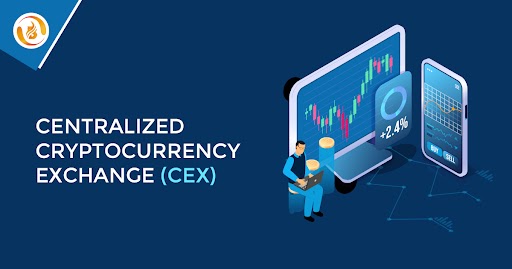Introduction
If you want to sell and buy crypto, You will require a crypto exchange development, which can be divided into two main categories: centralized and Decentralized. The two kinds of trades are fundamental to the crypto economy, and each enjoys benefits, burdens, and remarkable highlights. Simply put, they are necessary for accessibility and ease of use, allowing novice crypto users to exchange their fiat currencies for crypto.
Many centralized cryptocurrency exchange (CEX) function similarly to banks. So, they expect clients to relinquish guardianship of their keys. However, not all centralized exchanges function this way; some offer distinct advantages. This blog has shared more critical things about centralized crypto exchanges and their benefit.
What is a Centralized Cryptocurrency Exchange (CEX)?
A platform known as a centralized exchange is owned and operated by a single entity that acts as a link between buyers and sellers. This intermediary or third party facilitates transactions by providing support tokens with liquidity.
The centralized stage utilizes a request book framework to lay out crypto costs, similar to a conventional bank. Here, a client regularly stores assets into a record held by the trade, which goes about as a caretaker of those assets. Clients trust the stage to deal with their assets decently and safely. The crypto exchange handles trades for buyers and sellers and vice versa.
What are the types of Centralized Crypto Exchange?
a) Traditional CEX
These are the well-known centralized exchanges that have long dominated the cryptocurrency industry. This exchange adhere to regulations, offer a wide range of cryptocurrencies for trading, and have robust security measures.
b) CEX Brokerage
Business CEXs work on exchanging experience with fledglings and easy going brokers. These stages frequently offer easy-to-understand interfaces, instructive assets, and the capacity to trade digital forms of money with customary government-issued types of cash.
c) CEX via peer-to-peer (P2P)
Some CEXs work on a shared model, where purchasers and vendors communicate straightforwardly, and the trade goes about as an escrow administration. Bitcoiva is conspicuous instances of P2P CEXs working with direct exchanges between people.
Features of a Centralized Crypto Exchange
So, what are the requirements for an exchange to be “centralized”? Indeed, most centralized exchanges follow a comparable model. We should investigate what makes them extraordinary.
Represented by a single entity
The characterizing element of a brought-together trade is that it is constrained by a solitary substance, considering the quicker direction and ensuing execution of techniques. This implies smoother and more productive administrations.
Subsequently, CEXs can offer highlights like high-level exchanging instruments, government-issued money support, working on accounts for the executives, and client service. This permits them to draw in countless clients and proposition higher trading volumes and expanded liquidity, which means quicker exchange execution and more tightly offered ask spreads.
Yet, one association in control implies a weak link. Any issue at such a stage can have broad results, be it a specialized error, server blackout, or monetary trouble. Furthermore, since a solitary substance represents concentrated trades, it implies they are dependent upon the guidelines in a particular locale. This can leave your assets powerless against administrative activity, particularly troubling in nations with draconian regulations.
Additionally, you put your faith in the exchange to carry out your trades honestly and fairly. You can only do something if a centralized entity decides to mismanage your funds. Front-running, market manipulation, and even insider trading are all possible outcomes.
Lastly, centralized management implies that organizational strategy often needs to be addressed. You need to have the foggiest idea about the standards on which the trade works. That might be fine if you only use an exchange to buy crypto and store your assets elsewhere.
Custodial Wallets
Centralized exchanges employ security measures to safeguard user funds and personal information, including a secret phrase, two-factor confirmation (2FA), cold capacity, withdrawal limitations, and regular security reviews.
Be that as it may, a CEX ordinarily expects you to utilize their custodial wallets. This implies saving your assets into accounts under the trade’s influence. You get the login subtleties to get to the wallet, yet you must possess it. The trade holds the Record’s confidential key, and you are basically “acquiring” the wallet to execute and store your crypto. This absence of possession accompanies a gamble: The centralized element that controls your assets might repudiate your entrance at a time.
Require KYC
Lastly, CEXs likewise require official records to check your identity. This is because CEXs are businesses and are, as such, subject to local laws. This implies by utilizing such trades, you need protection, being compelled to impart your delicate data to centralized elements.
How are centralized crypt exchanges implemented?
A centralized exchange uses an order book system to make crypto trading more accessible. The request book is an electronic rundown a CEX keeps up with. It records all the trade orders, showing the cost and amount of each request. A request book records progressing exchange movement and lets the client see the ongoing business sector profundity and liquidity.
It works: Users place buy or sell orders on the CEX, and the exchange matches the orders and executes the trade for a fee when the prices match.
How are centralized crypt exchanges implemented?
Suppose you desire to purchase crypto utilizing government-issued money, say USD. In that case, you must use a centralized exchange, as most DEXs don’t uphold government-issued money like dollars or euros. They only accept crypto, instead. If you’re buying crypto for the first time, you’ll usually need to use a CEX and go through the KYC process.
Conclusion
Centralized cryptocurrency exchange development offers various advantages to clients in the digital money space. The centralized idea of these trades considers better liquidity, quicker exchanges, and an easy-to-use interface. Moreover, they offer different exchanging highlights, for example, limit orders, stop-misfortune orders, and edge exchanging, which can improve the exchanging experience.
Visit us at: www.biovustechnologies.com







